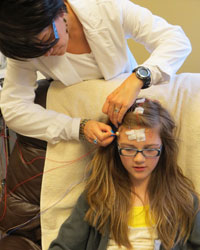
Electroencephalography (EEG)
Electroneurodiagnostics
Electroneurodiagnostic (END) technology is the study and recording of electrical activity of the brain and nervous system. Technologists record electrical activity arising from the brain, spinal cord, peripheral nerves, somatosensory or motor nerve systems using a variety of techniques and instruments. A neurologist interprets the test results and reports these findings to referring physicians as necessary.
Common electroneurodiagnostic procedures include the electroencephalogram (EEG), long-term monitoring, and nerve conduction studies.

Electroencephalogram (EEG)
The EEG is a recording of the on-going electrical activity of the brain. An EEG can assist in the diagnosis of a variety of neurological problems-from common headaches and dizziness to seizure disorders, strokes and degenerative brain disease. The EEG is also used to determine organic causes of psychiatric symptoms and disabilities in children.
Sleep-Deprived EEG
This test is similar to a regular EEG, as described above, except that you will be asked to achieve 4 fewer hurs of normal sleep or as directed by your provider prior to your exam.

Ambulatory EEG
This test is similar to a regular EEG, as described above, except without video and takes place in the comfort of your home.
Overnight Video EEG / Long Term Monitoring (LTM)
An overnight video EEG is a prolonged EEG study accompanied by continuous video monitoring, which can record both the clinical events and EEG recording to aid in the diagnosis of seizures and other neurological disorders. You will have electrodes placed with a water-soluble paste and be monitored during the afternoon and into the evening.